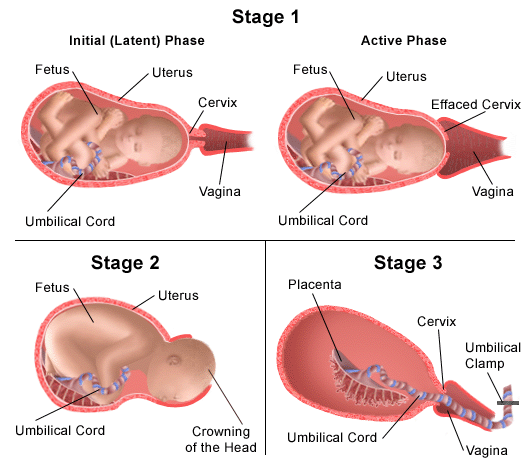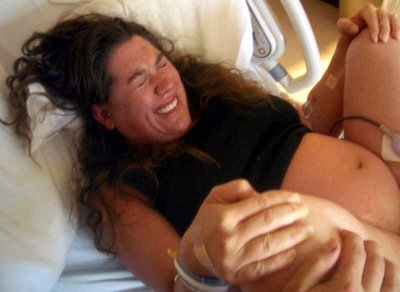
Stages of Labor
Being pregnant and giving birth can be an exciting time for the whole family. This page gives details on what pregnant women must endure during the delivery of the infant. The diagram below explains the stages of labor in graphical details. Each stage will be discussed more in depth.

Stage One:
The first state of labor begins with the onset of contractions that cause progressive changes in the cervix and ends when the cervix is fully dilated. This stage is divided into two phases: early (also known as latent), and active labor (the later part of this phase is referred to as transition). This phase is the longest phase of labor.
During early labor, the cervix gradually effaces (thins out) and dilates (opens). Once the contractions are occurring at relatively regular intervals and the cervix begins to progressively dilate and efface, early labor has officially started. The length of time that early labor takes is unknown because early labor contractions are sometimes hard to distinguish from Braxton Hicks. Most women notice an increase in mucusy vaginal discharge during early labor. This discharge is often tinged with blood and is called bloody show. This phase of stage one labor usually ends when the cervix is about 3 to 4 centimeters dilated and the progress of labor starts to accelerate.
Following early labor, the woman will go into active labor. This phase occurs when the contractions are occurring every five minutes and lasting 40 to 60 seconds each. Some women’s contractions are much more frequent, but the contractions generally tend to be mild and last less than a minute.
With active labor the cervix begins to dilate more rapidly and the contractions are longer, stronger and closer together. During this time the cervix dilates from about 3 to 4 centimeters to 10 centimeters. With active labor, the baby generally starts to descend. Some women request pain (usually an epidural) during this stage of labor.
The later part of this phase is also referred to as transition. This last part of active labor is when the cervix dilates from 8 to 10 centimeters. This is called the transition period because it marks the shift into the second stage of labor. This time frame is when the most intense part of labor occurs. Contractions are usually very strong, occurring every 2 to 3 minutes and lasting a minute or more. Often the woman may start shaking and shivering. By the time the cervix is fully dilated and the transition is over, the baby has usually descended somewhat into the pelvis. Some women may claim they feel rectal pressure, as if they need to move their bowels. Quite often a lot of bloody discharge occurs and the woman may feel nauseated or even vomit. She may also have back pain and possibly diarrhea. The transition period may take anywhere from a few minutes to a few hours.

Stage Two:
The second stage of labor, also referred to as the pushing stage, begins once the cervix is fully dilated and ends with the birth of the infant. At the beginning of this stage the woman’s contractions may be a little further apart, giving the woman a chance for rest in between. Some women find the contractions during this stage easier to handle because bearing down offers relief during the contractions. The urge to push generally comes when the infant is resting very low in the pelvis. The infant is moved into this position during uterine contractions. When the uterus contracts it puts pressure on the infant. That pressure, along with the pushing done by the woman, will move the infant in a downward motion and into the birth canal. The infant’s descent may be rapid or gradual. When a contraction is over and the uterus relaxes, the babies head will recede slightly. After time, the perineum (the tissue between the vagina and the rectum) will begin to bulge during pushing and before long the babies scalp will be visible. When the widest part of the infants head is finally visible, the infant is “crowning”. Shortly after the crowning the infant’s face will begin to appear: the forehead, nose, mouth and chin.

After the infant emerges the caregiver will suction the mouth and nose and feel around the neck to see if the umbilical cord is present. The woman will then be encouraged to continue pushing so that the shoulders and body can be delivered.
Following the birth the infant should be suctioned again to make sure all mucous is free of the airway. The infant should be stimulated and kept warm (the baby may lay against the mother’s bare skin with a blanket or simply cleaned and wrapped up). The infant should have a hat since a good deal of heat is lost through the head.
The entire second stage can last anywhere from a few minutes to several hours.
Stage Three:
The third and final stage of labor begins after the birth of the infant and ends with the separation and subsequent delivery of the placenta. Minutes after giving birth the woman’s uterus will be to contract again. The first several contractions usually separate the placenta from the uterine wall. When the caregiver is seeing signs of separation the woman should be encouraged to push so that the placenta can be expelled from the body. This usually occurs with one push and is generally not that difficult or painful. This process usually takes 5 to 10 minutes.
Following the delivery of the placenta the uterus should continue to contract and get very firm. At this point the contractions, which are very mild, are helping to cut off and collapse open blood vessels at the site where the placenta was attached. If this does not occur the woman will continue to bleed profusely from those blood vessels.
If the woman is planning on breastfeeding, she should be given the option as to whether she would like to attempt feeding the infant at this point in time. Quite often the new mother and infant are too tired to feed. Most babies are generally ready to begin nursing within the first hour or so after delivery, if given the chance. Early nursing is good for the baby and for the new mother. Nursing triggers the release of Oxytocin. This is the same hormone that causes contractions and will help the uterus stay firm and well contracted.
Some women may choose to, or may require, having an episiotomy. This procedure consists of the care giver (in hospital settings) cutting a slit in the woman’s perineum to widen the cervix for easier passage for the infant. Some women do not have episiotomies and will tear during birth. After the delivery of the infant and the placenta the caregiver will use a local anesthetic to numb the area and then stitch.
** For women that choose to have an epidural, the process of labor for all three stages may take longer than listed above. For women who have had children vaginally before the current pregnancy, the process of labor may go more rapidly. All times and amounts given are generalized.

To see videos of actual childbirth go to www.youtube.com and type in childbirth.
Resources:
www.mayoclinic.com
www.babycenter.com
Comments (0)
You don't have permission to comment on this page.